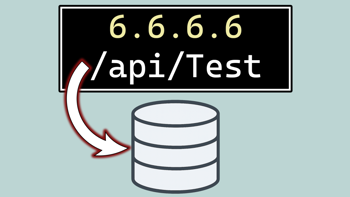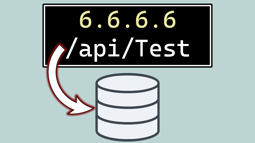- Home
- .NET tutorials
- Four reasons why your ASP.NET Core application is not working in IIS
Four reasons why your ASP.NET Core application is not working in IIS
Published: Tuesday 15 September 2020
We are going to explore four potential reasons why your ASP.NET Core Application is not working in IIS.
Now the reason why I'm writing this article is because I've had a few people get in contact with me as a result of my article "How to Publish an ASP.NET Core & React SPA to IIS".
They were saying they still couldn't get their ASP.NET Core application to work in IIS, despite following the recommendations in that article.
So, that's explore the reasons why this might be the case and come up with some rememdies.
Problem #1: Permissions
So you've published your ASP.NET Core application. You've set up a website in IIS pointing to your published folder.
Tried to run the application. And then IIS throws an error that reads as follows:
HTTP Error 500.19 - Internal Server Error
The requested page cannot be accessed because the related configuration data for the page is invalid.
Config Error: Cannot read configuration file due to insufficient permissions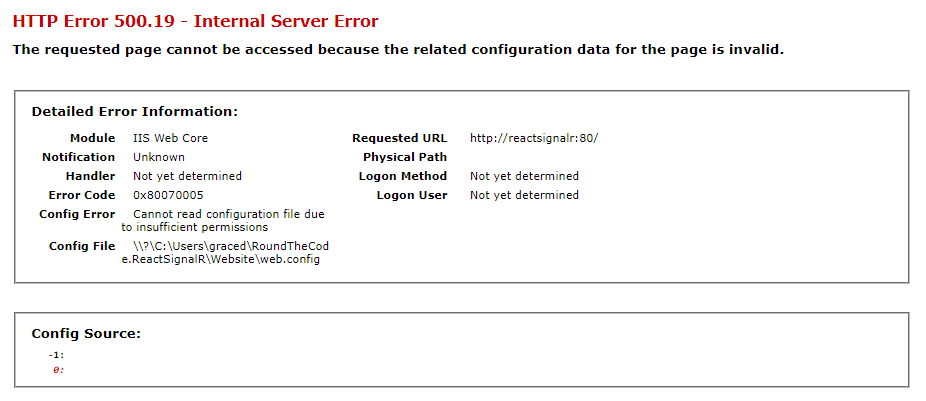
500.19 Error when Running an ASP.NET Core Application in IIS
This error is because IIS does not have the correct permissions to render your ASP.NET Core application.
In Windows 10, you need to give full access to the IIS_IUSRS group in the path where you are hosting your ASP.NET Core application in IIS.
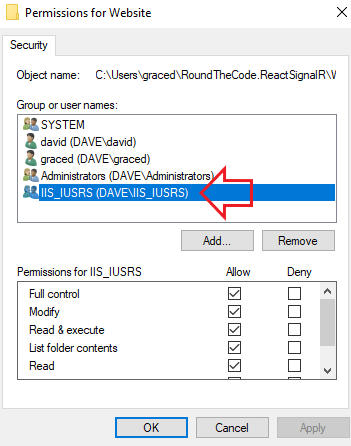
In Windows 10, give IIS_IUSRS Full Control to your ASP.NET Core Application in IIS
This should resolve your issue.
However, what if that group is not there? Or it doesn't resolve the issue?
If the group is not there, you can add the Users group to the folder that's running your ASP.NET Core application in IIS. And give it full permission. That should at least get your application working.
But, it might be that you've changed the identity of the application pool in IIS. You might be running your IIS application from a different user.
In which case, in IIS, go to Application Pools and click on the pool running your application.
Go to Advanced Settings... and navigate to Process Model and Identity.
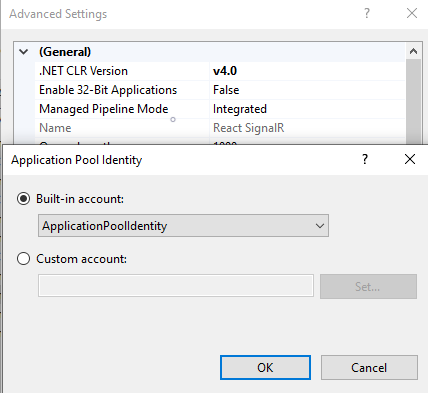
Check the Application Pool Identity in IIS when running an ASP.NET Core Application
If you are using a Custom Account, you will probably need to give full permissions to that account as well.
Problem #2: Installing ASP.NET Core Runtime
If you are running an ASP.NET Core application, you must install ASP.NET Core Runtime onto the machine that is running your application through IIS.
You can download ASP.NET Core Runtime from Microsoft's ASP.NET Core website. It will give you different installers dependent on which operating system you are using.
For IIS, it's recommended that you install the Hosting Bundle. Not only does this install ASP.NET Core Runtime, but also additional support for IIS runtime support.
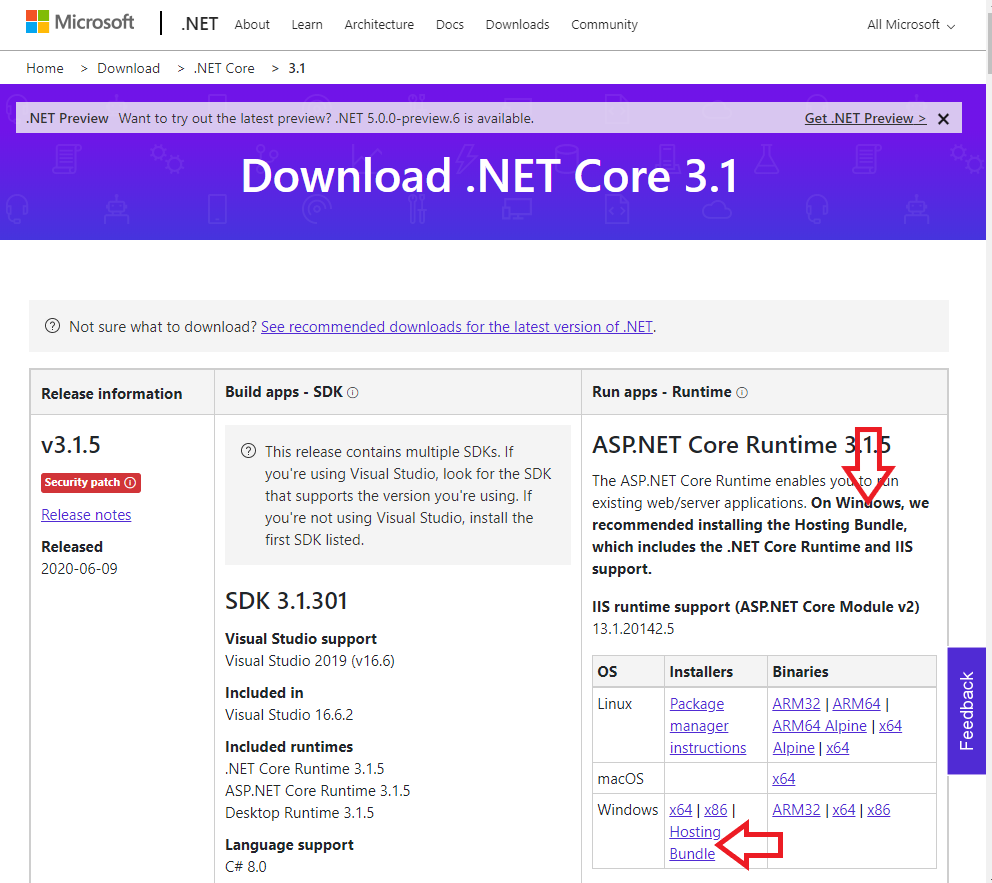
For IIS, download the Hosting Bundle from the Windows OS to download ASP.NET Core Runtime & additional IIS runtime support
Problem #3: Different ASP.NET Core Runtime Version
It's easily done. You've successfully deployed your ASP.NET Core application onto IIS and everything is fine.
That is until you upgrade your ASP.NET Core version. You try and deploy it to IIS and then you get a 500 error.
Here is an example of trying to run an ASP.NET Core 3 application with ASP.NET Core Runtime 1 installed.
The error reads:
HTTP Error 500.21 - Internal Server Error
Handler "aspNetCore" had a bad module "AspNetCoreModuleV2" in its moudle list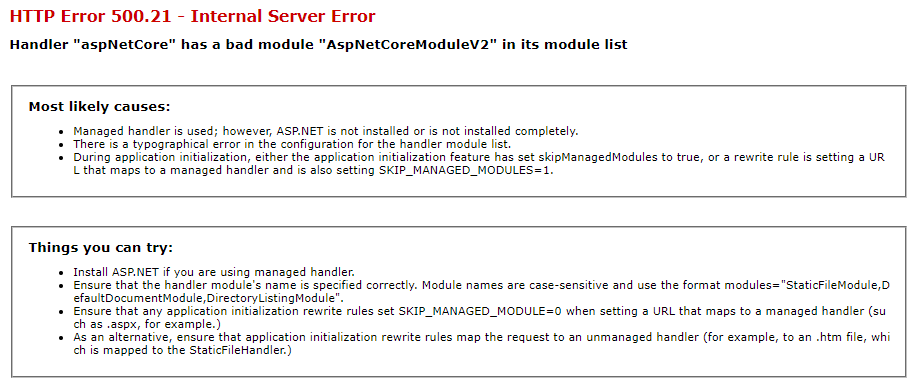
500.21 Error when Running an ASP.NET Core 3 Application with ASP.NET Core Runtime 1
Now I must stress that you might not get any error when you upgrade your ASP.NET Core version for your application without upgrading your ASP.NET Core Runtime.
But, it's worth keeping it up to date.
Problem #4: A Runtime Error With Your Application
This one was raised by Chaker Aich on my YouTube channel.
So you've tried all these solutions, but you are still getting a 500 error.
This one is more specific as it relates to a start up failure.
HTTP Error 500.30 - ANCM In-Process Start Failure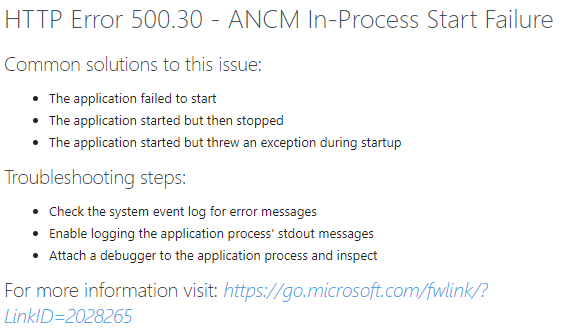
500.30 Error when Running an ASP.NET Core Application in IIS
This is a problem with your ASP.NET Core application rather than IIS. There is a runtime error.
First, check that it runs locally on your machine. Assuming you are using Visual Studio, open the application in Visual Studio and run the application.
If it throws an error, you will know the reason why you are getting a 500.30 error in IIS.
However, if it's working fine, there is probably something wrong with the IIS environment. Maybe the server cannot see the database? Or maybe, there is something that hasn't been installed on the server?
To help you identify the issue, you can turn on log files.
In the directory that is running your ASP.NET Core application in IIS, you should have a web.config file.
In there, you should have an aspNetCore tag with a stdoutLogEnabled and stdoutLogFile attribute.
<?xml version="1.0" encoding="utf-8"?>
<configuration>
<location path="." inheritInChildApplications="false">
<system.webServer>
<handlers>
<add name="aspNetCore" path="*" verb="*" modules="AspNetCoreModuleV2" resourceType="Unspecified" />
</handlers>
<aspNetCore processPath="dotnet" arguments=".\RoundTheCode.ReactSignalR.dll" stdoutLogEnabled="false" stdoutLogFile=".\logs\stdout" hostingModel="inprocess" />
</system.webServer>
</location>
</configuration>Now the stdoutLogEnabled attribute should be set to false. By setting that to true, you should be able log the runtime error that you are getting in your application.
The log files are stored in the folder path that is contained in the stdoutLogFile attribute.
Still Stuck?
If you are not quite following the solutions to the fixes, you can watch us demonstrate these errors and applying fixes.
We go ahead and publish our ASP.NET Core application to a folder, ready for IIS to host.
Afterwards, we set the appropriate permissions that IIS needs to render your ASP.NET Core application.
Then, we go ahead and install the ASP.NET Core Runtime onto our machine.
Lastly, we demonstrate the checks you can use to deal with any runtime errors you are getting when running your ASP.NET Core application in IIS.
Latest tutorials

Read & write to a CSV file using a list in ASP.NET Core
Learn how to read and write CSV files in ASP.NET Core using lists, including handling headers and mapping different header titles easily.